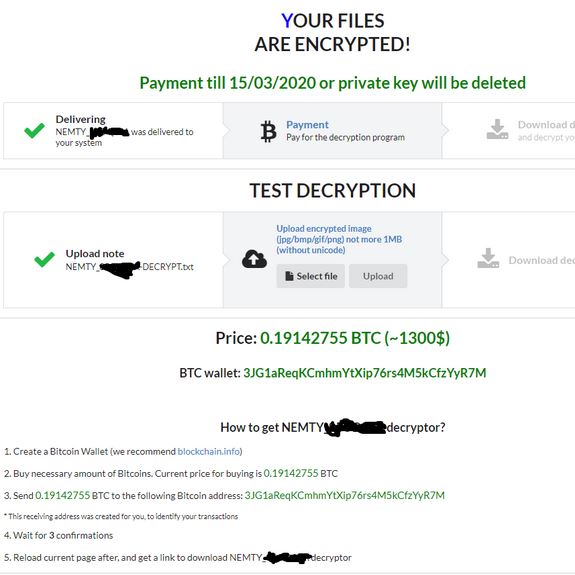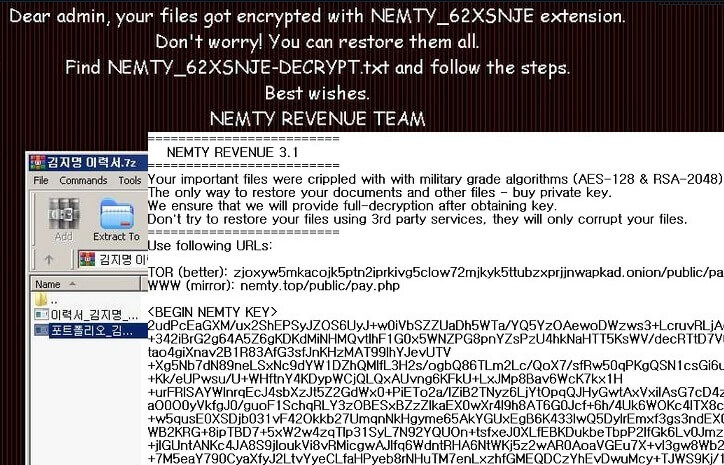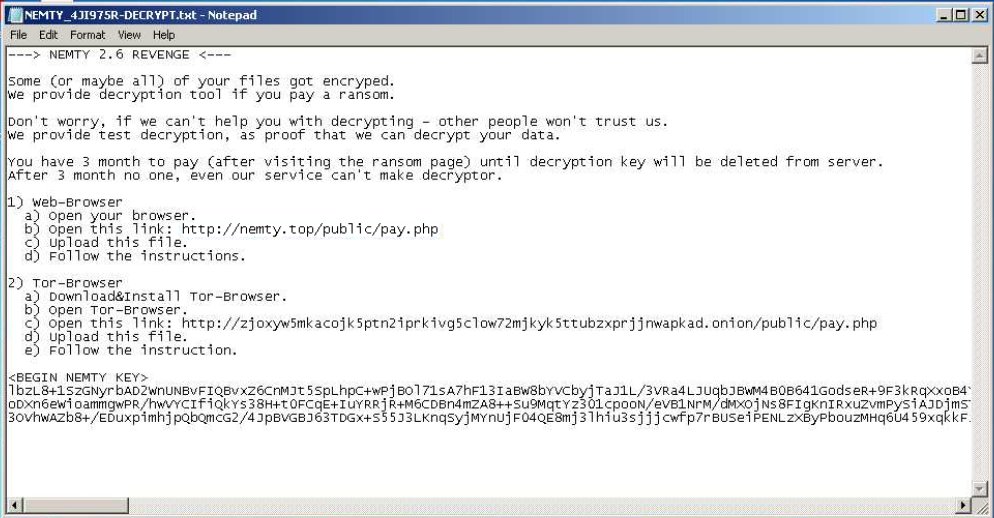What is Nemty 2.3 Virus ransomware? How does Nemty 2.3 Virus work? How to open Nemty 2.3 Virus files? How to remove Nemty 2.3 Virus and try to restore files, encrypted by it?
The Nemty 2.3 Virus is actually a ransomware infection, whose main idea is to make sure that you won’t be able to use your files anymore, until you pay ransom to the cyber-criminals who are behind it. The main idea of this is that your files get blocks of their data replaced with data from the AES encryption algorithm used by the Nemty 2.3 Virus.
Nemty 3.1 then adds its own file extension and drops a ransom note file. This file’s main purpose is to get victims to pay ransom to get your files to be decrypted using the unique decryption key that is generated and held by the crooks. Read this article to learn how to remove NEMTY from your computer and learn how to recover data encoded by it.

Threat Summary
| Name | Nemty 2.3 Virus |
| Type | Ransomware, Cryptovirus |
| Short Description | Aims to encrypt files and then ad its custom file extension to them. |
| Symptoms | Files are encrypted and cannot be opened. The Nemty 2.3 Virus also drops a ransom note file, containing the extortionist message. |
| Distribution Method | Spam Emails, Email Attachments, Executable files |
| Detection Tool |
See If Your System Has Been Affected by malware
Download
Malware Removal Tool
|
User Experience | Join Our Forum to Discuss Nemty 2.3 Virus. |
| Data Recovery Tool | Windows Data Recovery by Stellar Phoenix Notice! This product scans your drive sectors to recover lost files and it may not recover 100% of the encrypted files, but only few of them, depending on the situation and whether or not you have reformatted your drive. |
NEMTY Ransomware Virus 3.1 – Update April 2020
New updates have already hit the Web space with the release of the latest variant of the NEMTY ransomware, namely Nemty 3.1 virus. There are changes to the ransomware note, desktop background image, and a few other minor changes, including the files which deliver the malware. In the screenshot given down here, you can see the new background, malicious archive opened and the changes to the ransom note’s text:
As you can see, the version is updated, there are still these huge encryption keys and some new information. The note states the following:
—> NEMTY 3.1 REVENUE <--- Some (or maybe all) of your files got encryped. We provide decryption tool if you pay a ransom. Don't worry, if we can't help you with decrypting - other people won't trust us. We provide test decryption, as proof that we can decrypt your data. You have 3 month to pay (after visiting the ransom page) until decryption key will be deleted from server. After 3 month no one, even our service can't make decryptor. 1) Web-Browser a) Open your browser. b) Open this link: hxxp://nemty.top/public/pay.php c) Upload this file. d) Follow the instructions. 2) Tor-Browser a) Download&Install Tor-Browser. b) Open Tor-Browser. c) Open this link: hxxp://zjoxyw5mkacojk5ptn2iprkivg5clow7 2mjkyk5ttubzxprjjnwapkad.onion/public/pay.php d) Upload this file. e) Follow the instruction.
The .txt file may differ than the online ransom instructions a bit in terms of text. No further changes are reported by malware researchers at this time. If any new information is found, this article will get duly updated.
NEMTY Virus 2.6 Released in March 2020
Security researchers discovered a new release of the Nemty ransomware family this time bearing the version number 2.6. This new NEMTY 2.6 virus has been detected in a phishing email campaign that appears to be set against Korean targets. At the moment there is no information regarding the full feature and code changes however the minor version change gives researchers several assumptions. First of all as this is not a major revision the main engine is probably the same. Minor version changes indicate a change in custom parameters in most cases: this may include the infection strategy. In this particular case the method of choice is the sending of phishing messages. The hackers can choose to either link the malware files in the contents or directly attach them.
Changes in the way the virus infects can include the inclusion of new modules or the modification of already existing ones. In many cases where such changes are implemented there may be individual malware action specific modifications. An example would be the modification of Windows Registry keys — the virus may add in new entries for itself or choose to remove certain values used by other applications or the operating system. Another example is when the engine will start to edit configuration files — they can be of user-installed applications or the operating system. The effects of this can be severe performance issues and the inability to start certain services. The newer version of the NEMTY virus code can also choose to delete additional files thereby making it very hard to restore the affected computers.
Nemty 2.6 Virus – Update March 2020
Nemty Ransomware brings a new version in March 2020. Unfortunately, the cryptovirus does not seem to stop being updated by its makers. The newest iteration is Nemty 2.6. The new extension is .NEMTY_xxxxxxx where the X-marks represent a random combination of symbols. The ransom note is called NEMTY_xxxxxxx-DECRYPT.txt and its name is generated by the same principle as observed with the extension. You can see the ransom note below:
Nemty 2.6 is just as bad and annoying as 2.3 and there are no hopes for a decryptor yet.
Love Letter Spam Nemty 2.3 Virus Distribution
A new group of Nemty 2.3 virus samples have been found to be distributed using email messages that impersonate secret lovers. This is a common technique which uses social engineering tricks in order to manipulate the victims into believing that a person is secretly in love with the recipients.
There are multiple subject lines which can be used to spread these messages:
- Don’t tell anyone
- I love you
- Letter for you
- Will be our secret
- Can’t forget you
The email messages contain files attachment which are usually archives that will contain a dangerous file containing the virus code. They can be usually macro-infected documents or JavaScript code. When they are opened by the users the virus infection will begin.
Detailed information about some of the latest distribution tactics became available to us. It appears that the hackers behind the ransomware are using advanced methods in order to infect as many users as possible. In August 2019 one of the tactics was to deliver the threat via the Trik botnet — a powerful network of infected hosts that is also known under its alternative name Phorpiex. The hackers have customized it to send out a massive wave of SPAM email messages that use sextortion tactics. They use social engineering blackmail contents to manipulate the victims into interacting with the files (they are either linked or attached). A later update to the Trik botnet added a SMB infection component that attempts to intrude onto target users via vulnerable remote desktop software.
Nemty 2.3 Virus Ransomware – How Did I Get It and What Does It Do?
The Nemty ransomware family has been found updated with a new version, the new iteration is called Nemty 2.3 and it is possible that the new release has been created by a hacking group responsible for the prior threats. This is because the new version is a customized version meaning that the developers must have had access to the code of the previous Nemty viruses.
This gives us reasons to believe that once again the most common distribution techniques will be used once again. Usually the hackers will use those tactics that have the highest chance of infecting as many targets as possible. In the case of ransomware like the Nemty 2.3 virus this can be various phishing strategies that will scam the victims into thinking that they have received a legitimate message or service notification via email or that they have accessed a safe website. To confuse the users the criminals will use similar sounding domain names and self-signed security certificates.
Another popular scenario is the creation of virus-infected files — they can be either documents containing malicious macros (and of all popular formats) or dangerous application installers of popular software. These are the most popular files which are downloaded from the web and those that can integrate virus code in the easiest way. All of these files can be easily uploaded to different file-sharing networks like BitTorrent.
An in-depth analysis of some of the captured versions shows that the infection starts immediately after the user executes the relevant payload carrier. In the case of this particular malware a common infection causes is the opening up of a macro-infected document. A capture sample shows that Nemty 2.3 ransomware infections have been made by the running of text documents in Microsoft Word. Other formats can also carry the infection — presentations, databases and spreadsheets.
The Nemty 2.3 virus will launch an extensive malware behavior pattern which is programmed by the criminals. The extensive damages this ransomware will cause can be very difficult to recover unless the victims us a professional-grade anti-malware tool! One of the first actions done against the system is the removal of sensitive data: Shadow Volume Copies, recovery files, user backups and etc.
To completely recovery the affected computers the victims will need to use a combination of a ransomware removal program and a data recovery solution. The next step is to stop running processes based on a built-in list of apps that are to be bypassed. This includes not only security software, but also end user programs that are commonly used by the users. There is an important distinction between Nemty 2.3 and other ransomware is that it will also disable any running database servers, including enterprise installations. This particular characteristic shows that the ransomware is very suitable against corporate networks.
The analysis shows that the Nemty 2.3 virus will also be set to run every time the computer is started. This is made possible by reconfiguring the operating system configuration files and accessing the system preferences. In some cases such changes can also make it impossible to enter into some of the recovery boot options.
Given the complexity of the ransomware additional modules can be added at a later date by the hackers.
The Nemty 2.3 ransomware will feature the classical encryption phase by using a list of target file type extensions. A very strong cipher will be used to make them inaccessible to the users. However instead of marking the victim data with a single extension, each individual computer will have a different one based on the following scheme — .NEMTY_xxxxxxx. The ransomware note will be created in a similar manner: NEMTY_xxxxxxx-DECRYPT.txt.
The custom string is calculated by a special algorithm that will take various values from the compromised machines.

Remove Nemty 2.3 and Try Restoring Files
To remove Nemty 2.3 Virus from your computer, we strongly recommend that you read the instructions underneath. They have been created with the primary purpose to help you remove the Nemty 2.3 Virus files and try to restore all encrypted data. For a faster and effective removal, we strongly recommend that you download and run a scan of your computer using a professional malware removal software. Such program has been made with the main idea to help you erase all traces of the Nemty 2.3 Virus from your machine by scanning for its files and objects. It can also protect you from future threats and intrusive software of this type.
- Step 1
- Step 2
- Step 3
- Step 4
- Step 5
Step 1: Scan for Nemty 2.3 Virus with SpyHunter Anti-Malware Tool



Ransomware Automatic Removal - Video Guide
Step 2: Uninstall Nemty 2.3 Virus and related malware from Windows
Here is a method in few easy steps that should be able to uninstall most programs. No matter if you are using Windows 10, 8, 7, Vista or XP, those steps will get the job done. Dragging the program or its folder to the recycle bin can be a very bad decision. If you do that, bits and pieces of the program are left behind, and that can lead to unstable work of your PC, errors with the file type associations and other unpleasant activities. The proper way to get a program off your computer is to Uninstall it. To do that:


 Follow the instructions above and you will successfully delete most unwanted and malicious programs.
Follow the instructions above and you will successfully delete most unwanted and malicious programs.
Step 3: Clean any registries, created by Nemty 2.3 Virus on your computer.
The usually targeted registries of Windows machines are the following:
- HKEY_LOCAL_MACHINE\Software\Microsoft\Windows\CurrentVersion\Run
- HKEY_CURRENT_USER\Software\Microsoft\Windows\CurrentVersion\Run
- HKEY_LOCAL_MACHINE\Software\Microsoft\Windows\CurrentVersion\RunOnce
- HKEY_CURRENT_USER\Software\Microsoft\Windows\CurrentVersion\RunOnce
You can access them by opening the Windows registry editor and deleting any values, created by Nemty 2.3 Virus there. This can happen by following the steps underneath:


 Tip: To find a virus-created value, you can right-click on it and click "Modify" to see which file it is set to run. If this is the virus file location, remove the value.
Tip: To find a virus-created value, you can right-click on it and click "Modify" to see which file it is set to run. If this is the virus file location, remove the value.
Before starting "Step 4", please boot back into Normal mode, in case you are currently in Safe Mode.
This will enable you to install and use SpyHunter 5 successfully.
Step 4: Boot Your PC In Safe Mode to isolate and remove Nemty 2.3 Virus





Step 5: Try to Restore Files Encrypted by Nemty 2.3 Virus.
Method 1: Use STOP Decrypter by Emsisoft.
Not all variants of this ransomware can be decrypted for free, but we have added the decryptor used by researchers that is often updated with the variants which become eventually decrypted. You can try and decrypt your files using the instructions below, but if they do not work, then unfortunately your variant of the ransomware virus is not decryptable.
Follow the instructions below to use the Emsisoft decrypter and decrypt your files for free. You can download the Emsisoft decryption tool linked here and then follow the steps provided below:
1 Right-click on the decrypter and click on Run as Administrator as shown below:

2. Agree with the license terms:
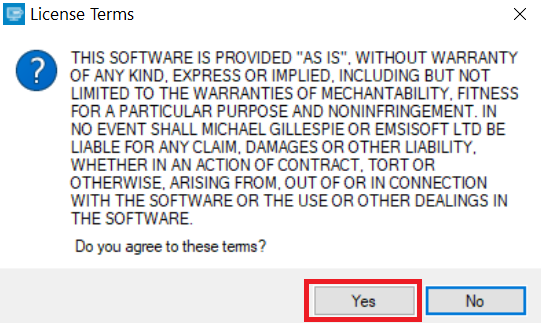
3. Click on "Add Folder" and then add the folders where you want files decrypted as shown underneath:
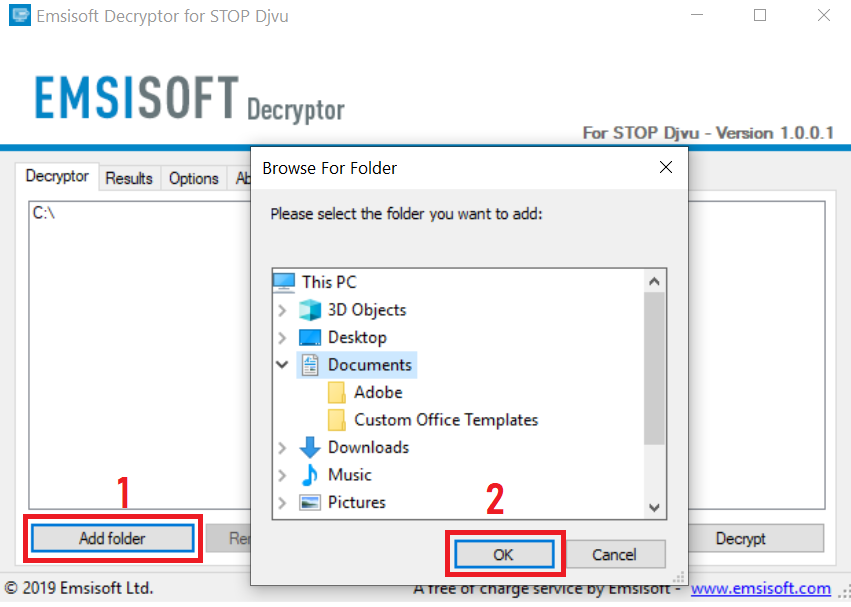
4. Click on "Decrypt" and wait for your files to be decoded.
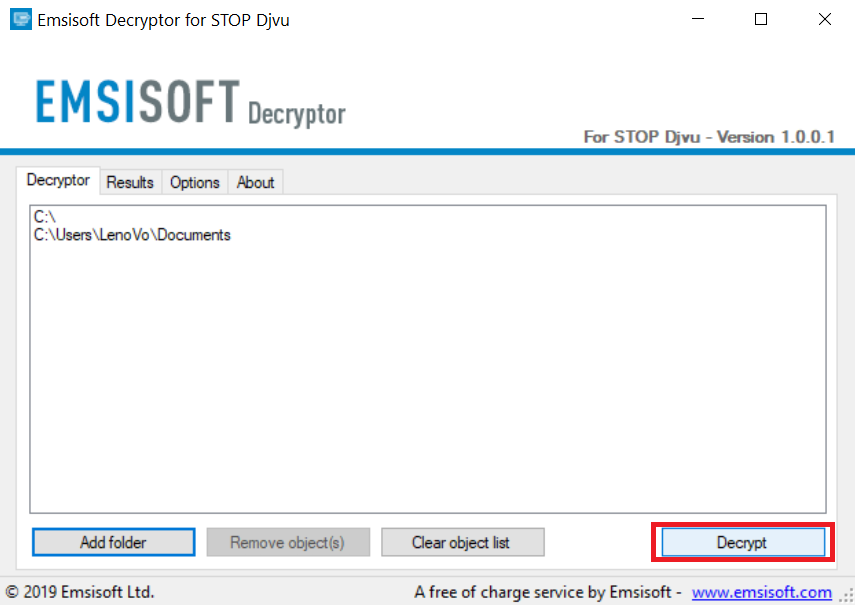
Note: Credit for the decryptor goes to Emsisoft researchers who have made the breakthrough with this virus.
Method 2: Use data recovery software
Ransomware infections and Nemty 2.3 Virus aim to encrypt your files using an encryption algorithm which may be very difficult to decrypt. This is why we have suggested a data recovery method that may help you go around direct decryption and try to restore your files. Bear in mind that this method may not be 100% effective but may also help you a little or a lot in different situations.
Simply click on the link and on the website menus on the top, choose Data Recovery - Data Recovery Wizard for Windows or Mac (depending on your OS), and then download and run the tool.
Nemty 2.3 Virus-FAQ
What is Nemty 2.3 Virus Ransomware?
Nemty 2.3 Virus is a ransomware infection - the malicious software that enters your computer silently and blocks either access to the computer itself or encrypt your files.
Many ransomware viruses use sophisticated encryption algorithms to make your files inaccessible. The goal of ransomware infections is to demand that you pay a ransom payment to get access to your files back.
What Does Nemty 2.3 Virus Ransomware Do?
Ransomware in general is a malicious software that is designed to block access to your computer or files until a ransom is paid.
Ransomware viruses can also damage your system, corrupt data and delete files, resulting in the permanent loss of important files.
How Does Nemty 2.3 Virus Infect?
Via several ways.Nemty 2.3 Virus Ransomware infects computers by being sent via phishing emails, containing virus attachment. This attachment is usually masked as an important document, like an invoice, bank document or even a plane ticket and it looks very convincing to users.
Another way you may become a victim of Nemty 2.3 Virus is if you download a fake installer, crack or patch from a low reputation website or if you click on a virus link. Many users report getting a ransomware infection by downloading torrents.
How to Open .Nemty 2.3 Virus files?
You can't without a decryptor. At this point, the .Nemty 2.3 Virus files are encrypted. You can only open them once they are decrypted using a specific decryption key for the particular algorithm.
What to Do If a Decryptor Does Not Work?
Do not panic, and backup the files. If a decryptor did not decrypt your .Nemty 2.3 Virus files successfully, then do not despair, because this virus is still new.
Can I Restore ".Nemty 2.3 Virus" Files?
Yes, sometimes files can be restored. We have suggested several file recovery methods that could work if you want to restore .Nemty 2.3 Virus files.
These methods are in no way 100% guaranteed that you will be able to get your files back. But if you have a backup, your chances of success are much greater.
How To Get Rid of Nemty 2.3 Virus Virus?
The safest way and the most efficient one for the removal of this ransomware infection is the use a professional anti-malware program.
It will scan for and locate Nemty 2.3 Virus ransomware and then remove it without causing any additional harm to your important .Nemty 2.3 Virus files.
Can I Report Ransomware to Authorities?
In case your computer got infected with a ransomware infection, you can report it to the local Police departments. It can help authorities worldwide track and determine the perpetrators behind the virus that has infected your computer.
Below, we have prepared a list with government websites, where you can file a report in case you are a victim of a cybercrime:
Cyber-security authorities, responsible for handling ransomware attack reports in different regions all over the world:
Germany - Offizielles Portal der deutschen Polizei
United States - IC3 Internet Crime Complaint Centre
United Kingdom - Action Fraud Police
France - Ministère de l'Intérieur
Italy - Polizia Di Stato
Spain - Policía Nacional
Netherlands - Politie
Poland - Policja
Portugal - Polícia Judiciária
Greece - Cyber Crime Unit (Hellenic Police)
India - Mumbai Police - CyberCrime Investigation Cell
Australia - Australian High Tech Crime Center
Reports may be responded to in different timeframes, depending on your local authorities.
Can You Stop Ransomware from Encrypting Your Files?
Yes, you can prevent ransomware. The best way to do this is to ensure your computer system is updated with the latest security patches, use a reputable anti-malware program and firewall, backup your important files frequently, and avoid clicking on malicious links or downloading unknown files.
Can Nemty 2.3 Virus Ransomware Steal Your Data?
Yes, in most cases ransomware will steal your information. It is a form of malware that steals data from a user's computer, encrypts it, and then demands a ransom in order to decrypt it.
In many cases, the malware authors or attackers will threaten to delete the data or publish it online unless the ransom is paid.
Can Ransomware Infect WiFi?
Yes, ransomware can infect WiFi networks, as malicious actors can use it to gain control of the network, steal confidential data, and lock out users. If a ransomware attack is successful, it could lead to a loss of service and/or data, and in some cases, financial losses.
Should I Pay Ransomware?
No, you should not pay ransomware extortionists. Paying them only encourages criminals and does not guarantee that the files or data will be restored. The better approach is to have a secure backup of important data and be vigilant about security in the first place.
What Happens If I Don't Pay Ransom?
If you don't pay the ransom, the hackers may still have access to your computer, data, or files and may continue to threaten to expose or delete them, or even use them to commit cybercrimes. In some cases, they may even continue to demand additional ransom payments.
Can a Ransomware Attack Be Detected?
Yes, ransomware can be detected. Anti-malware software and other advanced security tools can detect ransomware and alert the user when it is present on a machine.
It is important to stay up-to-date on the latest security measures and to keep security software updated to ensure ransomware can be detected and prevented.
Do Ransomware Criminals Get Caught?
Yes, ransomware criminals do get caught. Law enforcement agencies, such as the FBI, Interpol and others have been successful in tracking down and prosecuting ransomware criminals in the US and other countries. As ransomware threats continue to increase, so does the enforcement activity.
About the Nemty 2.3 Virus Research
The content we publish on SensorsTechForum.com, this Nemty 2.3 Virus how-to removal guide included, is the outcome of extensive research, hard work and our team’s devotion to help you remove the specific malware and restore your encrypted files.
How did we conduct the research on this ransomware?
Our research is based on an independent investigation. We are in contact with independent security researchers, and as such, we receive daily updates on the latest malware and ransomware definitions.
Furthermore, the research behind the Nemty 2.3 Virus ransomware threat is backed with VirusTotal and the NoMoreRansom project.
To better understand the ransomware threat, please refer to the following articles which provide knowledgeable details.
As a site that has been dedicated to providing free removal instructions for ransomware and malware since 2014, SensorsTechForum’s recommendation is to only pay attention to trustworthy sources.
How to recognize trustworthy sources:
- Always check "About Us" web page.
- Profile of the content creator.
- Make sure that real people are behind the site and not fake names and profiles.
- Verify Facebook, LinkedIn and Twitter personal profiles.













